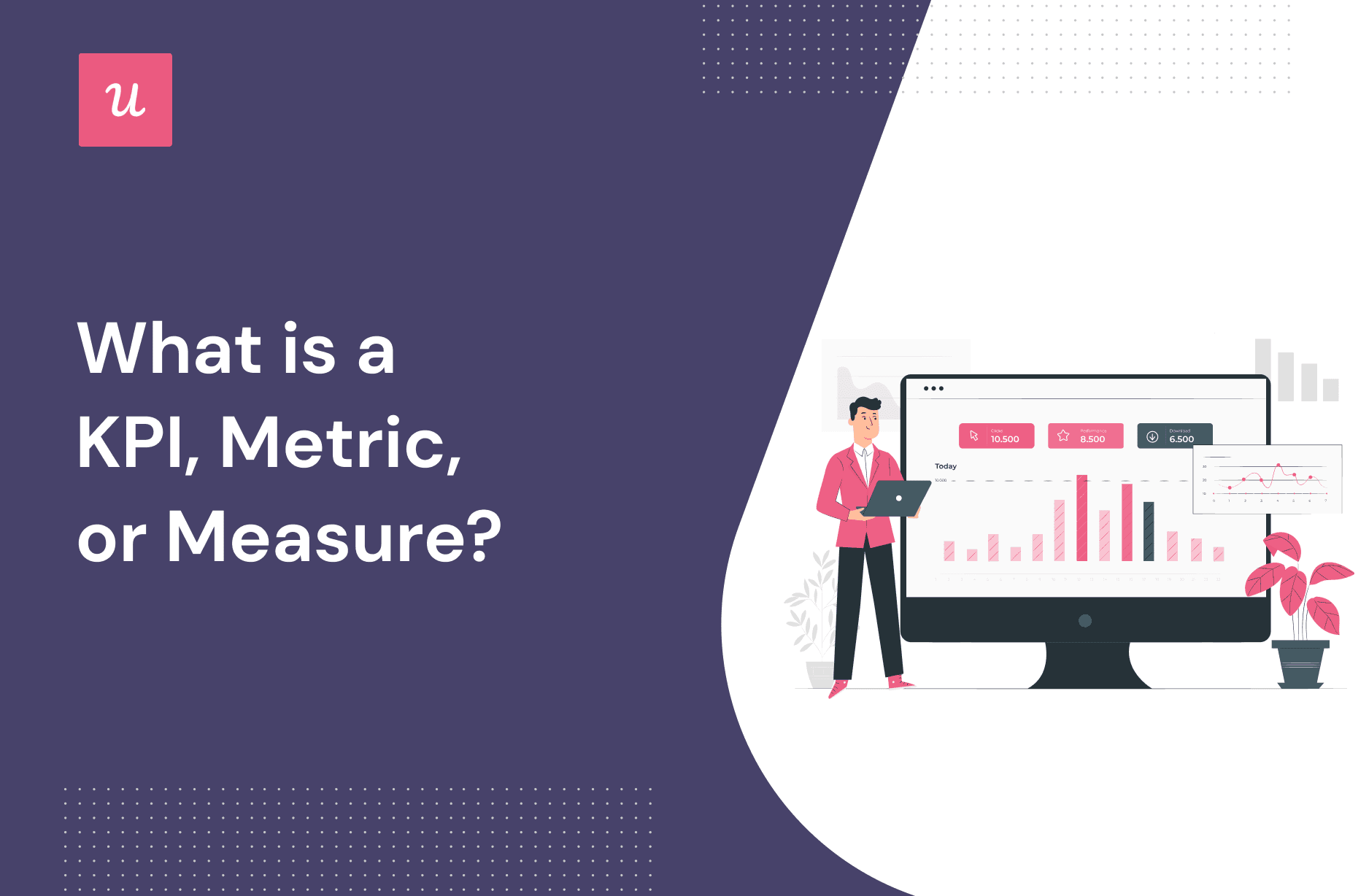
When it comes to KPIs vs metrics, which one should you measure to get better insights? What about metrics and measures?
In the world of SaaS, all three terms serve a specific purpose. Metrics and KPIs are often used interchangeably, but they also have differences.
The more you understand these nuances, the better you can evaluate your product growth strategy. In this article, you will learn:
- What is a KPI in SaaS?
- What does metric refer to in SaaS?
- KPIs vs. Metrics
- What is a measure in SaaS?
- Why is it so important to track KPI, metric, or measure?
Let’s dive in!
Try Userpilot Now
See Why 1,000+ Teams Choose Userpilot

What are key performance indicators (KPI) in SaaS?
Let’s start with key performance indicators. KPIs measure the progress of a specific business goal or objective. The word “key” implies that it tracks only what’s relevant to your business’s strategic decisions.
A good KPI keeps you from heading in the wrong direction and helps your company grow. Some of the most common KPIs in SaaS businesses are customer retention, customer lifetime value, revenue per client, and revenue growth.
What is a metric in SaaS?
A metric refers to any quantitative measure that can be used to track business performance. These are used as performance measures in various aspects of the business. In any SaaS business, you can use multiple metrics to measure progress. Here are some of the most important ones:
- Website traffic is a metric that shows the number of visitors your page gets.
- Customer acquisition cost (CAC) measures the money spent to acquire one customer.
- Customer retention rate is the number of customers you keep over a given period.
- Trial-to-paid conversion rate refers to the number of users who switched to the paid version of your product after their trial period.
When it comes to tracking business goals and monitoring your actions, not all metrics are crucial. To choose the right metrics, you must understand the relevant business areas.
What’s the difference between a metric and KPI?
To differentiate between KPIs and metrics, remember this: all metrics are KPIs, but not all KPIs are metrics. The two are not mutually exclusive.
Metrics can be any aspect of the business that can be measured. A metric becomes a KPI when it has a specific target and a timeframe and is relevant to a specific business goal.
Let us consider a scenario. As of January, your monthly recurring revenue (MRR) is $50,000, and your customer acquisition cost is $60. Your goal is to improve profits and achieve a sales growth of 40% by the end of the year.
A few changes need to be made to your marketing team so that you can achieve your business goals. You’ve hired four marketing specialists and started using new advertising platforms. You have also added new features to your software.
Now, how will you measure the success of your decisions? Bingo. These two business metrics have now become key performance indicators in your business plan. Revenue growth and/or a decrease in acquisition costs indicate that your changes are having a positive effect on your goals.

This is exactly why in the SaaS business, OKRs (objectives and key results) are most commonly used. Setting an objective is insufficient because it can be vague. The key results help you to narrow down and measure your progress more effectively.
Let’s say your business objective is to increase sales. The key result will be a 30% increase in sales by the end of the quarter.
What is a measure in SaaS?
Measures are values that can be summed or averaged. Measures of a typical SaaS business include the number of customers, active and inactive users, and features used.
The number of customers indicates how often your product has been purchased. You can use the number of features used to identify your product’s most popular functions and improve them.
Metrics and measures differ in the sense that a measure is a unit-specific term. Metrics are calculated based on measures.
The monthly recurring revenue (MRR) is calculated by multiplying the number of customers you have by the amount they pay you each month. If you have 30 customers who pay you $100 per month, your monthly MRR is $3,000.
Why is tracking KPIs, metrics, and measures important?
KPIs, metrics, or measures all have a numerical target that your business can set milestones based on.
They act as motivators, guideposts, and performance measures that steer the company in the right direction, making them a very important aspect of any SaaS business.
Why are metrics important?
It is critical to measure metrics since they cover a wide range of measurable business areas. They help you identify whether you’re on the right track or not.
By analyzing metrics, a company’s management can measure performance, make informed decisions, improve efficiency, save money, and utilize resources more effectively.
Why are KPIs important?
Businesses would be clueless about their performance if they did not set and track the right key performance indicators. They may believe they are succeeding, but what is the degree of success? What is it being compared to? They may be aware of the metrics that can be tracked, but which ones should they monitor?
With the correct KPIs, you are more likely to create appropriate goals, build strategies to achieve them, evaluate your progress, and eventually track your product success.
Why are measures important?
To calculate a metric or a key performance indicator, you need to use measures. These are the building blocks of metrics and KPIs. They help your team understand how the metrics are built and what components contribute to their growth or fall.
A metric cannot be calculated without understanding where it originated, i.e., without understanding where the measurements come from.
SaaS KPIs examples
KPIs act as a guide toward achieving specific business outcomes. They measure how effectively you are progressing towards your objectives.
For example, if you want to increase your business revenue, some of the KPIs you need to track include MRR and ARR growth, net churn, and customer retention rate.
If you want to measure customer loyalty, the KPIs you should track are churn rate, customer lifetime value, and the net promoter score (NPS).
SaaS metrics examples
SaaS metrics aim to provide value to your business by using data. They are tied to outcomes but they don’t necessarily give you any insights on specific business outcomes, such as revenue and growth.
It is important to keep in mind that not all metrics are relevant when making decisions. Metrics and KPIs depend on your objective.
Metrics focus more on smaller objectives, such as the efficiency of a team or the effectiveness of a new campaign. For example, if you want to increase retention, the main KPI you should track is customer retention. However, other important metrics also directly impact it, such as the activation rate, feature usage rate, adoption rate, and friction points in a specific user flow.
Do you need both KPIs, metrics, and measures for SaaS?
With all these terms, it can be pretty difficult to decide which one you need. In short, you need all three. Metrics, KPIs, and measures are all connected.
To start, you need to set outcomes. Using the North Star Checklist, you can determine your North Star Metrics (NSM). This consists of several key metrics that assess the success of your product and business as a whole.

To compile your North Star Metric, your teams need to find out One Metric That Matters (OMTMs) for a specific time frame. This will make it easier to identify what to track, helping you choose the most relevant KPIs and metrics.
What will you need to calculate these metrics? As measures are the building blocks used to quantify everything, you’ll need them to calculate the metrics. If you are missing measures, you haven’t set proper metrics and KPIs to track.

Best tools to track KPIs, metrics, and measures
Making the right decisions based on data is crucial to achieving success in SaaS. Here’s the tricky part: how do you measure the data in the first place?
There are a number of tools available in the market that allow you to navigate through this data, making it easy to calculate and track metrics, measures, and KPIs. While these tools handle complex calculations, you and your team can focus on leveraging the data.
Userpilot
Userpilot focuses on increasing product growth and in-app engagement. It allows you to create product experiences without having to code. By tracking user engagement and in-app behavior, you can create a contextual and personalized product experience. In addition, you can track active and inactive users.

Building on these capabilities, Userpilot’s new mobile features now also allow you to create intuitive mobile app KPI dashboards, offering clear insights into mobile user behavior, engagement, and retention.
Userpilot also allows you to create NPS surveys both on web and mobile apps. NPS surveys help you understand the loyalty of your customers and how likely they are to recommend your products to others. Additionally, it helps you track detractors, passives, and promoters.

Geckoboard
Geckoboard is a real-time KPI dashboarding tool that allows users to streamline data from many sources. Its user-friendly design makes business data understandable without requiring any coding.
Key business metrics are updated live to reflect current trends and changes. This helps you make smarter decisions by delivering correct data at the right time.

Databox
Databox is a cloud-based business analytics platform designed for analysts, CEOs, decision-makers, and marketers. It provides a single interface from which you can view KPIs and create reports.
They have numerous features, such as Goal Tracking, Alerts, and Scorecards which helps you track your company’s performances and teams remotely and stay up-to-date. It sends you notifications via email or mobile when your most important KPIs change.

Conclusion
In a nutshell, KPIs, metrics, and measures all show numbers that help you understand the effectiveness of your strategies and practices. These are connected and are very important when it comes to SaaS businesses.
These are directly tied to your business goals, so be sure to change them as your objectives change.
Want to get started with tracking metrics, KPIs, and measures? Get a Userpilot Demo and see how you can leverage business data and boost your product growth.







